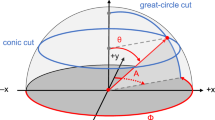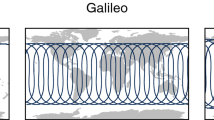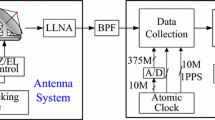Abstract
The signal-in-space of the first GPS Block III spacecraft is analyzed based on radio frequency measurements collected with a 30-m high-gain dish antenna as well as data from geodetic GPS receivers. The spectral properties and modulation characteristics are discussed with focus on the L1 band, which employs a novel interlaced majority voting technique for combination of the C/A, P(Y), and L1C data + pilot signal components. Compared to the preceding generation of Block IIF satellites, a modified shaping of the L1 transmit antenna gain pattern is found, which results in lower carrier-to-noise density ratios at mid to high elevations. Along with this, use of a separate transmission chain for the military M-code signal is evidenced through the analysis of in-phase/quadrature signal components and the derived transmit antenna gain variations. A high level of signal purity is demonstrated on all frequencies, which can be attributed to the use of a new, mostly digital, signal generation unit. Maps of code bias variations for selected signals are presented to quantify the achievable user tracking performance as a function of user receiver parameters. For the L5 signal, a notable reduction in digital distortions is obtained with respect to the Block IIF satellites, whereas analog distortions are found to be of similar magnitude. Thermally induced L5 phase variations found in the Block IIF satellites are no longer observed in GPS III. Using triple-frequency phase observations, a sub-centimeter consistency of the L1, L2, and L5 carriers is demonstrated.











Similar content being viewed by others
References
Allen DW, Arredondo A, Barnes DR, Betz JW, Cerruti AP, Davidson B, Kovach KL, Utter A (2019) Effect of GPS III weighted voting on P(Y) receiver processing performance. In: Proceedings of the ION ITM 2019, Institute of Navigation, Reston, Virginia, USA, January 28–31, pp 936–950. https://doi.org/10.33012/2019.16742
Betz J (2016) Engineering satellite-based navigation and timing—global navigation satellite systems, signals, and receivers. Wiley, Hoboken. https://doi.org/10.1002/9781119141167
Betz JW, Blanco MA, Cahn CR, Dafesh PA, Hegarty CJ, Hudnut KW, Kasemsri V, Keegan R, Kovach K, Lenahan LS, Ma HH, Rushanan JJ, Sklar D, Stansell TA, Wang CC, Yi KS (2006) Description of the L1C signal. In: Proceedings of the ION GNSS 2006, Institute of Navigation, Fort Worth, Texas, USA, September 26–29, pp 2080–2091
Chen YH, Lo S, Enge P, Akos D (2014) Direct comparison of the multipath performance of L1 BOC and C/A using on-air Galileo and QZSS transmissions. In: Proceedings of the IEEE/ION PLANS 2014, Institute of Navigation, Monterey, USA, May 5–8. https://doi.org/10.1109/plans.2014.6851447
Czopek FM, Shollenberger S (1993) Description and performance of the GPS Block I and II L-Band antenna and link budget. In: Proceedings of the ION GPS 1993, Institute of Navigation, Salt Lake City, Utah, USA, September 22–24, pp 37–43
Dafesh PA, Cahn CR (2009) Phase-optimized constant-envelope transmission (POCET) modulation method for GNSS signals. In: Proceedings of the ION GPS 2009, Institute of Navigation, Savannah, Georgia, USA, September 22–25, pp 2860–2866
Dafesh PA, Nguyen TM, Lazar S (1999) Coherent adaptive subcarrier modulation (CASM) for GPS modernization. In: Proceedings of the ION NTM 1999, Institute of Navigation, San Diego, California, USA, January 25–27, pp 649–660
EUROCAE (2019) Minimum operational performance standard for Galileo/Global Positioning System/Satellite-Based Augmentation System airborne equipment, ED-259, European Organization for Civil Aviation Equipment, February 2019
FRNP (2017) 2017 Federal radionavigation plan. Department of Defense, Department of Homeland Security, Department of Transportation; National Technical Information Service, Virginia, DOT-VNTSC-OST-R-15-01. https://www.navcen.uscg.gov/pdf/FederalRadioNavigationPlan2017.pdf
Frye JR (2017) General interplex technique for signal combining. Navigation 64(1):35–49. https://doi.org/10.1002/navi.179
Guo J, Geng J (2018) GPS satellite clock determination in case of inter-frequency clock biases for triple-frequency precise point positioning. J Geod 92(10):1133–1142. https://doi.org/10.1007/s00190-017-1106-y
Hegarty CJ, Ross JT (2010) Initial results on nominal GPS L5 signal quality. In: Proceedings of the ION GNSS 2010, Institute of Navigation, Portland, Oregon, USA, September 21–24, pp 935–942
Hein GW, Avila-Rodriguez J-A, Wallner S, Pratt AR, Owen J, Issler J, Betz JW, Hegarty CJ, Lenahan S, Rushanan JJ, Kraay AL, Stansell TA (2006) MBOC: the new optimized spreading modulation recommended for GALILEO L1 OS and GPS L1C. In: Proceedings of the IEEE/ION PLANS 2006, Institute of Navigation, Coronado, USA, April 25–27. https://doi.org/10.1109/plans.2006.1650688
IGS (2019) International GNSS service, daily 30-second observation data, Greenbelt, MD, USA:NASA Crustal Dynamics Data Information System (CDDIS). Accessed 18 Feb 2019. https://doi.org/10.5067/GNSS/gnss_daily_o_001
IS-GPS-200J (2018) NAVSTAR GPS space segment/navigation user segment interfaces. Global positioning system directorate systems engineering & integration. 25 April 2018. https://www.gps.gov/technical/icwg/IS-GPS-200J.pdf
IS-GPS-800E (2018) NAVSTAR GPS space segment/user segment L1C interface. Global positioning system directorate systems engineering & integration. 25 April 2018. https://www.gps.gov/technical/icwg/IS-GPS-800E.pdf
Johnston G, Riddell A, Hausler G (2017) The International GNSS Service. In: Teunissen P, Montenbruck O (eds) Springer handbook of global navigation satellite systems. Springer, New York, pp 967–982. https://doi.org/10.1007/978-3-319-42928-1_33
Kee C, Parkinson B (1994) Calibration of multipath errors on GPS pseudorange measurements. In: Proceedings of the ION GPS 1994, Institute of Navigation, Salt Lake City, Utah, USA, September 22–24, pp 353–362
Marquis WA, Reigh DL (2015) The GPS block IIR and IIR-M broadcast l-band antenna panel: its pattern and performance. Navigation 62(4):329–347. https://doi.org/10.1002/navi.123
Marquis W, Shaw M (2011) Design of the GPS III space vehicle. In: Proceedings of the ION GNSS 2011, Institute of Navigation, Portland, Oregon, USA, September 19–23, pp 3067–3075
Montenbruck O, Hugentobler U, Dach R, Steigenberger P, Hauschild A (2012) Apparent clock variations of the Block IIF-1 (SVN 62) GPS satellite. GPS Solut 16(3):303–313. https://doi.org/10.1007/s10291-011-0232-x
Pan L, Zhang X, Li X, Liu J, Guo F, Yuan Y (2018) GPS inter-frequency clock bias modeling and prediction for real-time precise point positioning. GPS Solut 22:76. https://doi.org/10.1007/s10291-018-0741-y
Partridge MD, Dafesh PA (2001) Code power measurement methodology for GPS block IIR-M and IIF on-orbit test procedures. In: Proceedings of the ION GPS 2001, Institute of Navigation, Salt Lake City, Utah, USA, September 11–14, pp 2764–2772
Phelts RE, Akos DM (2004) Nominal signal deformations: limits on GPS range accuracy. In: Proceedings of the international symposium on GNSS/GPS, Sydney, Australia, December 6–8
Phelts RE, Akos DM (2006) Effects of signal deformations on modernized GNSS signals. J Glob Position Syst 5(1):2–10
Phelts RE, Gao GX, Wong G, Heng L, Walter T, Enge P, Erker S, Thoelert S, Meurer M (2010) Aviation grade: new GPS signals—chips off the Block IIF. Inside GNSS 5(5):36–45
Rushanan JJ (2007) The spreading and overlay codes for the L1C signal. Navigation 54(1):43–51. https://doi.org/10.1002/j.2161-4296.2007.tb00394.x
Soellner M, Kurzhals C, Hechenblaikner G, Rapisarda M, Burger T, Erker S, Furthner J, Grunert U, Meurer M, Thölert S (2008) GNSS offline signal quality assessment. In: Proceedings of the ION GNSS 2008, Institute of Navigation, Savannah, Georgia, USA, September 16–19, pp 909–920
Spilker Jr JJ, Orr RS (1998) Code multiplexing via majority logic for GPS modernization. In: Proceedings of the ION GPS 1998, Institute of Navigation, Nashville, Tennessee, USA, September 15–18, pp 265–273
Thoelert S, Erker S, Meurer M (2009) GNSS signal verification with a high-gain antenna—calibration strategies and high quality signal assessment. In: Proceedings of the ION ITM 2009, Institute of Navigation, Anaheim, California, USA, January 26–28, pp 289–300
Thoelert S, Erker S, Furthner J, Meurer M (2010) Latest signal in space analysis of GPS IIF, COMPASS and QZSS. In: Proceedings of the NAVITEC 2010, ESA ESTEC, Nordwijk, The Netherlands, December 8–10
Thoelert S, Vergara M, Enneking C, Antreich F, Meurer M, Brocard D, Rodriguez CS (2014) Characterization of nominal signal distortions and impact on receiver performance for GPS (IIF) L5 and Galileo (IOV) E1/E5a signals. In: Proceedings of the ION GNSS + 2014, Institute of Navigation, Tampa, Florida, USA, September 8–12, pp 3113–3128
Vergara M, Sgammini M, Thoelert S, Enneking C, Zhu Y, Antreich F (2016) Tracking error modeling in presence of satellite imperfections. Navigation 63(1):3–13. https://doi.org/10.1002/navi.129
Acknowledgements
The International GNSS Service (IGS, Johnston et al. 2017) is acknowledged for providing GNSS observation data from their global network of monitoring stations. The authors want to thank their colleagues from the German Space Operations Center (GSOC) for supporting and operating the high-gain antenna at DLR’s ground station, Weilheim, Germany.
Author information
Authors and Affiliations
Corresponding author
Additional information
Publisher's Note
Springer Nature remains neutral with regard to jurisdictional claims in published maps and institutional affiliations.
Rights and permissions
About this article
Cite this article
Thoelert, S., Steigenberger, P., Montenbruck, O. et al. Signal analysis of the first GPS III satellite. GPS Solut 23, 92 (2019). https://doi.org/10.1007/s10291-019-0882-7
Received:
Accepted:
Published:
DOI: https://doi.org/10.1007/s10291-019-0882-7




